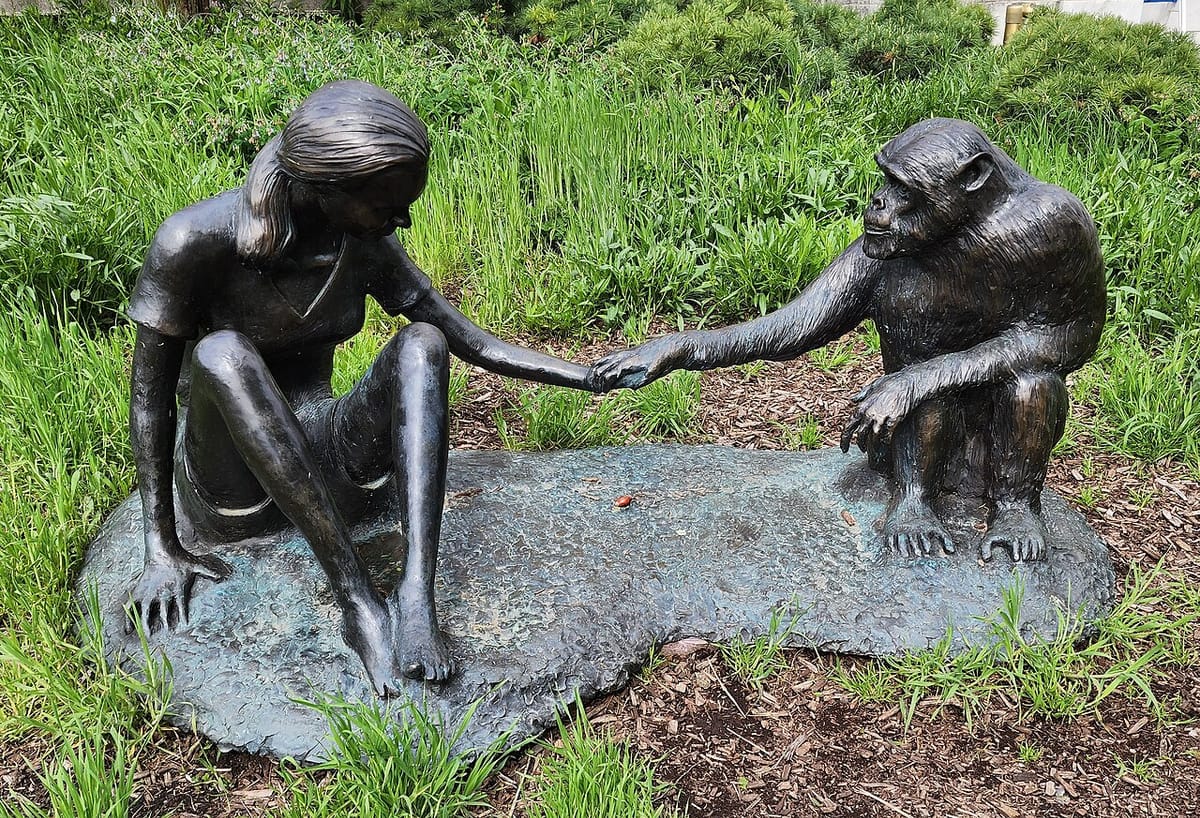On Jane Goodall

Jane Goodall was a celebrated figure in conservation. Her work with chimpanzees in the Gombe Stream National Park in Tanzania redefined primatology. However, more than a few publications as well as conservation experts writing on social media platforms have since her passing on October 1 called attention to the ways in which Goodall problematised conservation, not least by entrenching colonial ideas and attitudes and by defying empirical and ethnographic norms that, while they served her well, weren't always in the interests of research as a collaborative enterprise.
I'm writing this post to collect my own issues with her and her work in one place, for my reference; if it helps you too — great. (Note that I've already published an article in The Hindu alongside my colleague Radhika Santhanam on the specific ways in which Goodall pushed the boundaries of scientific research and their consequences.)
Goodall’s work in Africa began in 1960, a time of British colonial influence and her narrative — rather the narrative of her — often fit the "White saviour" archetype, centring a White researcher as the sole protector of a "pristine" African wilderness. This narrative overlooked the contributions and knowledge of local communities. The media, but especially National Geographic, helped sharpen this image of a lone White woman braving the African jungle. While this was a popular framing, it downplayed the role of the Tanzanians who worked alongside her. Men like Rashidi Kikwale and Eslom Mpongo were vital to her project's success, tracking the chimpanzees and gathering data, yet they received little public recognition.
This oversight also perpetuated a colonialist trope that overlooked the role of local expertise in scientific discoveries — and one that arguably helped to sustain similar patterns of (mis)acknowledgement in this and other domains, including "parachute science" and "parachute journalism".
Goodall's public statements on African population growth are somewhat relevant here: she suggested that a smaller human population would solve many environmental problems, a view with immutable racist undertones. It placed a disproportionate amount of blame on population growth in economically developing and under-developed nations while ignoring the much larger per-capita environmental impact of economically developed countries. Goodall also campaigned against bushmeat, a vital source of food for many communities, but not against the hunting of similar meat in Europe, which was referred to by the more prestigious and less stigmatised term of "game".
(Aside: Whataboutery, or tu-quoque, doesn't generally make for a good argument because it attempts to distract from a particular point by qualifying its validity on a different and perhaps unrelated one. Here, however, the double standard is important. I'm not saying "don't criticise bushmeat because you have game" but that "the principles used to criticise bushmeat are not being applied consistently to game hunting in Europe", and that this inconsistency reveals a cultural and economic bias. In fact the very words are loaded with prejudice: "bushmeat" often carries connotations of being primitive, illicit, unsanitary, and desperate, and is associated with poverty and the unregulated hunting of endangered species like primates, while "game" suggests tradition, sport, and nobility, evoking images of managed estates, recreational hunting by the wealthy, and fine dining. Goodall's language itself thus preframed the debate.)
Her early inspiration from the fictitious character 'Tarzan', a White man who dominated the African jungle, has also been noted by critics as reinforcing a colonial mindset, propping up a romanticised view of an Africa devoid of complex human societies.
In 1975, Goodall married Derek Bryceson, a powerful figure in Tanzania given he was the director of the country's national parks as well as a member of parliament. She has said that without his political influence, Gombe National Park might not exist today. This implies what she left unsaid, that without Bryceson her own work may not have been possible, which in turn raises discomfiting questions about what privileges her marital union with Bryceson afforded her that were deprived to others.
Bryceson also protected Gombe through high-level political interventions, which may have set a precedent for a conservation effort that banked on powerful individuals rather than on community-based initiatives. While Goodall’s later work did emphasise community involvement, it remains that the initial survival of her research site was tied to her marriage to a government official.
Goodall’s fame also gave her a platform to speak on many issues. She has been an advocate for animal welfare and environmental protection — but she has also commented on topics far from her area of expertise. One of the most significant controversies surrounds her views on genetically modified organisms (GMOs). Goodall has been a vocal opponent of crop biotechnology. Many scientists have criticised her for this stance stating that her claims are not supported by scientific evidence. I know her 2013 book 'Seeds of Hope' also contains factual errors as well as passages plagiarised from anti-GMO websites. But her celebrity status conferred undue weight to her opinions even when they contradicted the scientific consensus on GMO safety. The tragic irony is that GMO technology stands to benefit economically developing countries as well as endangered species the most. Goodall even expressed openness to the existence of creatures like "Bigfoot".
This problem is tied closely with Goodall’s attitudes towards her research methods, which were unconventional from the start. She lacked a formal university degree when she began her research and she developed her own techniques. One of her most famous, and controversial, practices was to name the chimpanzees she studied. At the time, scientific convention demanded that researchers use numbers to avoid emotional attachment and maintain objectivity. Naming the chimpanzees helped to portray them as individuals with personalities and emotions. This was a significant departure from the view of animals as unthinking subjects and was instrumental in changing the public perception of chimpanzees and other animals. Many scientists now acknowledge the existence of animal personalities, a shift that Goodall helped to pioneer.
However, her methods also had a downside. Goodall’s close interactions with the chimpanzees, including feeding them, likely altered their natural behaviour. Some researchers have suggested that the "Gombe Chimpanzee War", a period of intense intergroup violence that Goodall documented, may have been exacerbated by her provisioning of food. That is, the artificial food source could have increased competition and aggression among the chimpanzee groups. While her deep empathy for the chimpanzees was a strength in many ways, attributing human-like motivations and emotions to animals can sometimes lead researchers to misinterpret their behaviour. Her approach thus brought the inner lives of chimpanzees to the forefront but also raised valid questions about the rigour of her early work.
Attributing complex human emotions and intentions to animals is a fraught enterprise. While both scientists and many non-scientists' attitudes towards animal personality have changed in the years since Goodall's first observations, with many experts now studying this aspect of the animal kingdom more actively, her early work sometimes lacked objective, behavioural descriptions and relied too heavily on subjective interpretation.
Standardised methods exist for a reason — to provide a common framework within which scientists can compare each other's notes and data — and defying them risks isolating findings and stunting progress. Science is also not static; its methods are in a state of (progressive) flux. Contrary to what Goodall did, however, change shouldn't happen as outright defiance but in the form of a structured, evidence-based, and consultative process. Methodological innovation needs to be integrated in a way that maintains the comparability and integrity of scientific knowledge and keeps the door open to researchers' attempts to reproduce each other's work.
A related question concerns researchers' ability to generalise Goodall's findings from Gombe to all chimpanzees. The population in Gombe is a single, small, and isolated group. The behaviour of these chimpanzees, but especially those influenced by artificial feeding and intense human observation, may not be typical for the species as a whole. Studies of other chimpanzee groups in different environments have also revealed variations in tool use, social structure, and levels of aggression.
Goodall's close interaction with the chimpanzees also created a significant risk of zoonotic disease transmission, from humans to chimps and vice versa. Humans and chimpanzees are genetically similar and thus susceptible to many of the same illnesses. There have been many polio and respiratory disease outbreaks at Gombe and park administrators have suspected humans to have been the source. This is why contemporary primatology enforces strict distancing protocols today.



